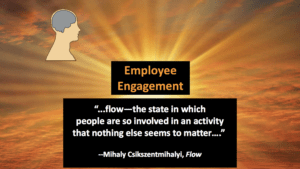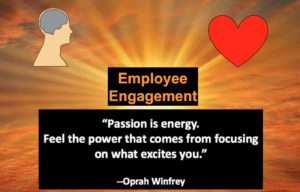What is the definition of employee engagement?
So what is the “real” definition of employee engagement? If you review the research, you’ll find several employee engagement definitions. But most definitions are consistent with the following:
To clarify, employee engagement is:
- The expression of a person’s preferred self in a work role
- The dedication of one’s cognitive energy, affective energy, and physical energy to one’s work
So, what does it mean for people to be their preferred selves at work? It means that when engaged employees go to work, they can be themselves. No role playing–they do what they love to do. When engaged, work does not feel like work. Instead, work is a means of self expression. In other words, imagine putting one’s whole self into one’s job.
Next, what does it mean to dedicate one’s energy to one’s work? To clarify, engaged workers are:
- Cognitively focused: to clarify, they are attentive and absorbed in their work.
- Affectively connected: that is to say, they direct their emotions and feelings toward their work.
- Physically active: to sum up, their behaviors and actions demonstrate extra effort and vigor.
Employees are totally engaged when they invest all their energies in their work.
Go to this link for the YouTube video “What Is Employee Engagement?”
Background on employee engagement definitions
Kahn’s seminal definition of engagement
Most researchers cite William A. Kahn when discussing engagement in the workplace and a definition of employee engagement. Kahn used the term “personal engagement” in his research (in the Academy of Management Journal, 1990).
According to Kahn,
“Personal engagement is the simultaneous employment and expression of a person’s ‘preferred self’ in task behaviors that promote connections to work and to others, personal presence (physical, cognitive, and emotional), and active, full role performances.”
Kahn describes engagement as the ideal situation where employees do not sacrifice either themselves or their roles at work. They are
“…physically involved in tasks, whether alone or with others, cognitively vigilant, and empathetically connected to others in the service of the work.”
An individual can be high in one dimension but not all three dimensions. The more involved one is in each dimension, the higher is one’s engagement.
Maslach’s definition: the positive antithesis of burnout
Another definition of employee engagement grew out of positive psychology. This research focuses on the positive aspects of work in contrast with the negative aspects of work. Burnout is a negative aspect of work. Christina Maslach and Susan Jackson (Journal of Occupational Behaviour, 1981) researched burnout and developed the Maslach Burnout Inventory (MBI). They described burnout as a psychological syndrome. Chronic interpersonal stressors at work result in burnout. Maslach’s definition of burnout consisted of the following dimensions:
- emotional exhaustion
- the individual’s feelings of being overextended and depleted of emotional and physical resources
- depersonalization
- interpersonal dimension of a negative, callous, or excessively detached response to aspects of the job
- the lack of personal accomplishment
- self-evaluation with feelings of incompetence and a lack of achievement and productivity in work
Building on that work, Maslach and colleagues described engagement on an engagement-burnout continuum. Burnout is at one end, and engagement is at the opposite end. Engagement is having the following:
- energy
- high levels of mental and physical resources in the work task
- involvement
- positive, attentive, and attached response
- efficacy
- feelings of competence and an ability to produce quality work
This is in contrast with burnout which was described as exhaustion, cynicism (depersonalization), and inefficacy.
Schaufeli’s definition of engagement
Building from the work of Maslach, Wilmar Schaufeli and colleagues (Educational and Psychological Measurement, 2006) defined engagement as:
“a positive work-related state of fulfillment that is characterized by vigor, dedication, and absorption.”
They developed the Work and Well-Being Survey. They called it the Utrecht Work Engagement Scale (UWES). Many studies on engagement use the UWES. In this scale, the dimensions are as follows:
“Vigor refers to high levels of energy and mental resilience while working, the willingness to invest effort in one’s work, and persistence in the face of difficulties.
Dedication is characterized by a sense of significance, enthusiasm, inspiration, pride, and challenge.
Absorption refers to being fully concentrated and deeply engrossed in one’s work, and is characterized by time passing quickly and difficulties in detaching oneself from work.”
Vigor and dedication are opposites of two of Maslach’s burnout dimensions. Absorption is a distinct dimension similar to the concept of flow (Csikszentmihalyi, 1990). Csikszentmihalyi described flow this way:
“Concentration is so intense that there is no attention left over to think about anything irrelevant, or to worry about problems. Self-consciousness disappears, and the sense of time becomes distorted. An activity that produces such experiences is so gratifying that people are willing to do it for its own sake, with little concern for what they will get out of it, even when it is difficult, or dangerous.”
Sak’s definition of job engagement and organization engagement
Alan N. Saks (Journal of Managerial Psychology, 2006) defined engagement as a distinct and unique construct that consisted of cognitive, emotional, and behavioral components associated with one’s role performance. But his view of engagement, based on his research, identified two types: job engagement and organization engagement.
- Job engagement refers to the individual being psychologically present in one’s role at work.
- Organization engagement refers to the individual being psychological present in one’s role as a member of the organization.
His research suggests a meaningful difference between the two types of engagement.
Engagement: a universal Priority of organizations
Most of the definitions of employee engagement highlight the investment of energy in one’s work. Energy can be physical, cognitive, and emotional. You can call it energy, vigor or something else. But engaged people invest their energy in all its forms–physical, cognitive and emotional.
The beauty of engagement is the harmony that exists between one’s self and one’s role. When doing the work nurtures all aspects of the individual, then the person achieves the ultimate experience of engagement.
Engagement is a universal Priority for organizations today. Above all, companies want engaged workers. It’s good for the company and good for those who work there. A workplace that values employee engagement is a humane workplace that nurtures the best in each individual.
Most companies conduct an Employee Engagement Survey to measure the level of engagement as well as the drivers of engagement. Go to this link for more information.
Contact Sheila to help you increase employee engagement
Have any questions? Contact Sheila. Her management consulting firm Workplace Culture Institute is based in Atlanta, serving clients globally. Use the contact form to email Sheila.
This site uses Akismet to reduce spam. Learn how your comment data is processed.



Leave a Reply